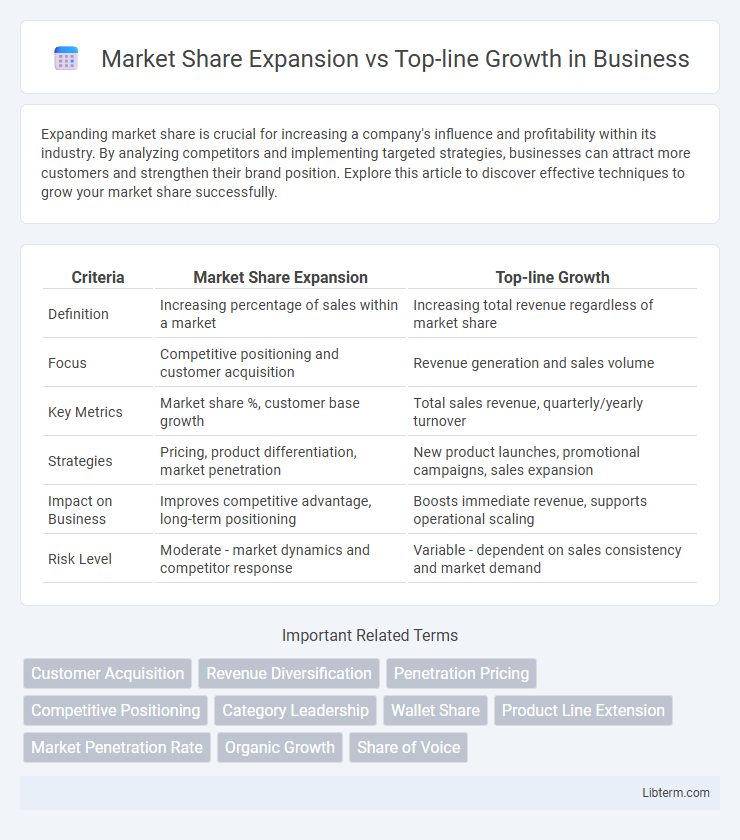Expanding market share is crucial for increasing a company's influence and profitability within its industry. By analyzing competitors and implementing targeted strategies, businesses can attract more customers and strengthen their brand position. Explore this article to discover effective techniques to grow your market share successfully.
Table of Comparison
| Criteria | Market Share Expansion | Top-line Growth |
|---|---|---|
| Definition | Increasing percentage of sales within a market | Increasing total revenue regardless of market share |
| Focus | Competitive positioning and customer acquisition | Revenue generation and sales volume |
| Key Metrics | Market share %, customer base growth | Total sales revenue, quarterly/yearly turnover |
| Strategies | Pricing, product differentiation, market penetration | New product launches, promotional campaigns, sales expansion |
| Impact on Business | Improves competitive advantage, long-term positioning | Boosts immediate revenue, supports operational scaling |
| Risk Level | Moderate - market dynamics and competitor response | Variable - dependent on sales consistency and market demand |
Understanding Market Share Expansion
Market share expansion refers to a company's ability to increase its percentage of total sales within a specific market compared to competitors, often through competitive pricing, product innovation, or enhanced customer experience. It directly influences long-term competitive positioning by capturing a larger portion of the available customer base, leading to greater brand recognition and market influence. Understanding market share expansion requires analyzing market dynamics, consumer behavior, and competitor strategies to identify growth opportunities and sustainable advantages.
Defining Top-line Growth
Top-line growth refers to the increase in a company's gross revenue or sales over a specific period, serving as a key indicator of business expansion and market demand. Unlike market share expansion, which focuses on increasing a company's percentage of total industry sales, top-line growth emphasizes overall revenue growth regardless of competitors' performance. Measuring top-line growth helps businesses evaluate their ability to attract new customers, enhance sales volume, and launch successful products or services in varying market conditions.
Key Metrics: Market Share vs Revenue Growth
Market share expansion directly reflects a company's competitive position within its industry, measured as the percentage of total sales captured relative to competitors. Revenue growth quantifies the absolute increase in sales dollars over a period, indicating overall business scalability and market demand. Analyzing the interplay between market share and revenue growth provides critical insights into whether growth stems from outperforming competitors or broader market expansion.
Strategies for Expanding Market Share
Expanding market share requires aggressive strategies such as competitive pricing, product innovation, and targeted marketing campaigns to attract new customers and retain existing ones. Leveraging data analytics and customer insights enables businesses to identify underserved segments and tailor offerings, boosting market penetration. Strategic partnerships and improving distribution channels also enhance market accessibility, driving sustained market share growth over top-line revenue expansion alone.
Approaches to Accelerate Top-line Growth
Accelerating top-line growth often involves leveraging innovative product development, expanding into high-potential markets, and optimizing pricing strategies to increase revenue streams. Emphasizing customer acquisition and retention through targeted marketing campaigns boosts sales volume, while strategic partnerships and digital transformation enhance market reach and operational efficiency. Aligning these approaches with data-driven insights enables businesses to swiftly capitalize on emerging trends and customer demands, fostering sustainable revenue growth.
Pros and Cons of Market Share Expansion
Market share expansion drives competitive positioning and long-term dominance by increasing a company's percentage of total sales within its industry, often leading to economies of scale and enhanced customer loyalty. However, pursuing market share can involve significant risks such as reduced profit margins from aggressive pricing strategies, increased marketing and operational costs, and potential overextension that strains company resources. This approach may sacrifice short-term revenue growth while focusing on capturing customers from competitors, making it essential to balance market share goals with sustainable top-line growth.
Advantages and Risks of Pursuing Top-line Growth
Pursuing top-line growth drives revenue increases, enhances market visibility, and attracts investment by boosting total sales figures. This strategy can capitalize on emerging market trends and new customer acquisition, fostering long-term business scalability. However, the risks include potential margin erosion from increased costs, operational strain, and the possibility of pursuing unsustainable growth that may neglect profitability and shareholder value.
Market Conditions Affecting Strategy Choices
Market conditions such as competitive intensity and customer demand volatility heavily influence the choice between market share expansion and top-line growth strategies. In highly saturated markets, pursuing market share expansion through aggressive pricing or product differentiation often leads to long-term dominance. Conversely, in emerging or rapidly growing markets, prioritizing top-line growth by capturing new customer segments or increasing sales volume typically drives immediate revenue gains.
Case Studies: Market Share Expansion vs Top-line Growth
Market share expansion often drives sustainable competitive advantage by increasing brand presence and customer loyalty, as demonstrated by Apple's strategy of ecosystem integration boosting its market dominance. In contrast, top-line growth through revenue increases, highlighted by Amazon's aggressive sales volume and diversification, can generate rapid financial scale but may face challenges in long-term profitability. Case studies reveal companies balancing both approaches, like Tesla, which expands market share via innovation while simultaneously driving top-line growth through scaling production and global market entry.
Choosing the Right Path for Sustainable Success
Focusing on market share expansion drives competitive advantage by increasing customer base and brand dominance, directly impacting long-term profitability. Prioritizing top-line growth emphasizes revenue increase through sales volume and new product introductions, fostering immediate financial gains. Balancing both strategies ensures sustainable success by aligning market position with continuous revenue generation and adaptability.
Market Share Expansion Infographic

 libterm.com
libterm.com